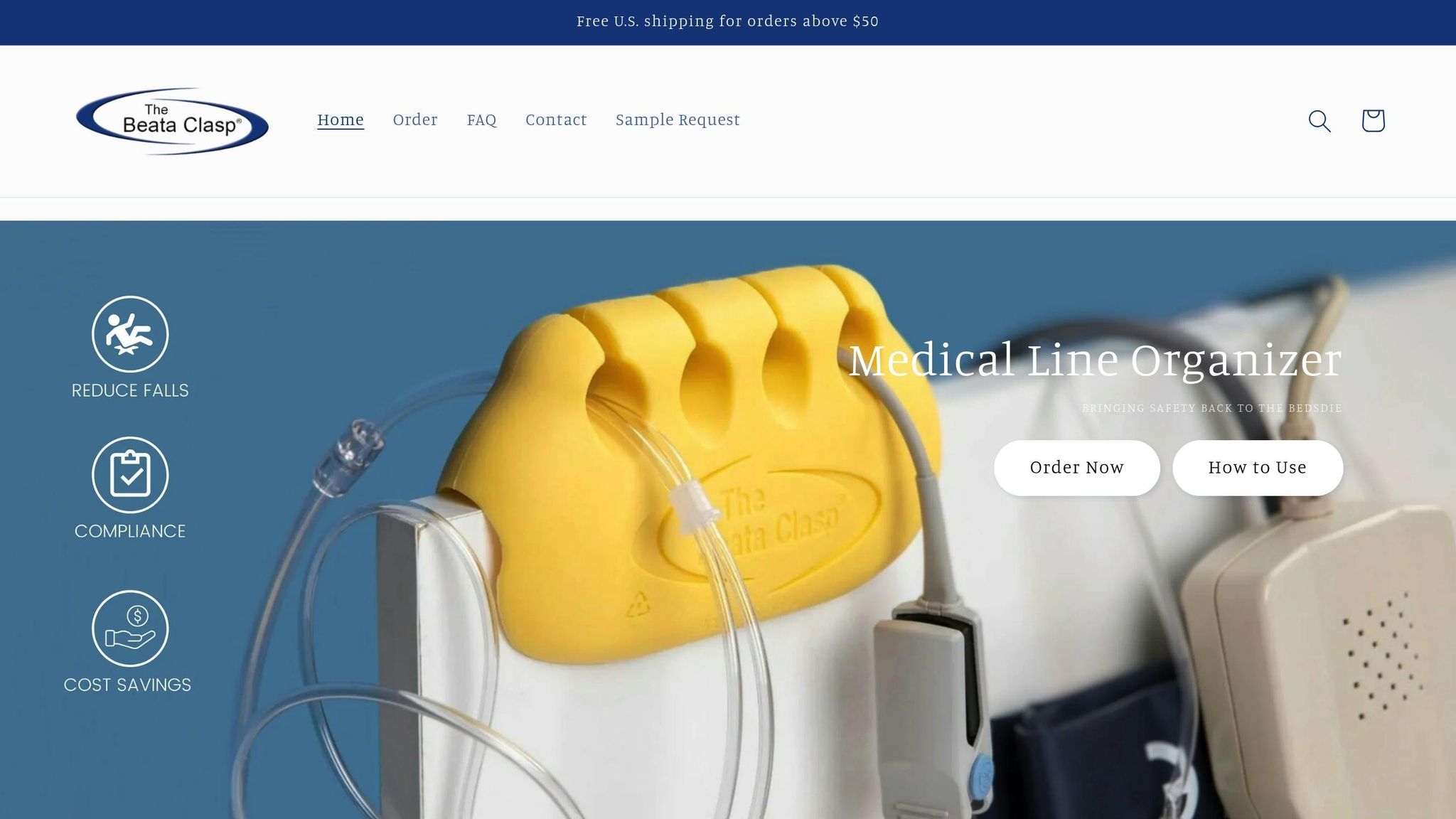In healthcare, managing IV tubing is more complex than ever. Mislabeling, tangled lines, and cross-contamination are common risks that can lead to medication errors, infections, and delayed treatments. To address these challenges, the Labeling, Management, and Alignment Protocol (LMAP) offers a structured approach to improve safety and reduce errors. Tools like the Beata Clasp further support this system by organizing lines, preventing tangles, and reducing contamination risks. Together, they simplify workflows, improve patient care, and reduce strain on healthcare staff.
Key takeaways:
- LMAP focuses on clear labeling, organized management, and logical alignment of IV lines.
- The Beata Clasp secures tubing, minimizes tangles, and supports infection control.
- Consistent training and compliance are essential for LMAP’s success.
- Future advancements may include smart monitoring and system integration for even better safety.
In the Know with RNAO Multiple IV Infusion Safety and Nursing Education Implications 20150629 1600 1

What is the LMAP System
The Labeling, Management, and Alignment Protocol (LMAP) system is a structured approach aimed at improving the safety of IV tubing. It addresses common risks like drug overdoses, underdoses, patient or medication misidentification, and delays in IV bag replacements. By doing so, it also helps ease the workload and fatigue experienced by nursing staff.
Main Components of LMAP
The LMAP system is built around three core elements:
- Labeling: Establishes clear and consistent standards to accurately match IV lines with the correct medications.
- Management: Introduces standardized procedures to simplify and organize workflows.
- Alignment: Ensures IV lines are arranged in a logical manner to minimize errors.
How LMAP Enhances Safety and Reduces Errors
By standardizing these processes, LMAP makes it easier to quickly verify and manage IV lines. This not only helps prevent mistakes during both routine and emergency care but also alleviates the physical and mental strain on nursing staff.
How to Use LMAP in Healthcare Settings
Strong policies and ongoing staff training are the backbone of successfully implementing LMAP. It all starts with well-defined protocols, as outlined below.
Maintaining Consistency and Compliance
To ensure effective use of LMAP, healthcare facilities need clear policies that cover labeling, alignment, and management processes. These guidelines should be reviewed and updated every three years - or sooner if regulations change.
Regular staff training is key to embedding LMAP principles into daily practices. This keeps everyone aligned and ensures consistent adherence. Additionally, periodic compliance assessments and thorough documentation play a critical role in improving patient safety outcomes.
sbb-itb-f779e18
Tools That Support LMAP: The Beata Clasp

Healthcare facilities require practical tools to bring LMAP into action, and the Beata Clasp is designed to meet those needs. Let’s take a closer look at how its design and features align with LMAP principles.
Beata Clasp Features and Benefits
The Beata Clasp, invented over 20 years ago by nurse Lenore, was originally created to prevent IV lines from being dislodged when bedrails are raised - a critical safety concern.
This device offers several features tailored to LMAP’s goals. Its adhesive-free design secures IV lines to bed rails without leaving sticky residue or causing skin irritation.
Each clasp includes multiple slots that can accommodate tubing up to 5/8 inch in diameter, making it easy to organize various IV lines in line with LMAP’s Management component.
Made from antimicrobial, latex-free material, the clasp is durable enough to withstand repeated sterilization. Its bright, high-alert color enhances visibility, addressing LMAP’s Alignment focus.
How Beata Clasp Enhances LMAP Implementation
The Beata Clasp provides a dedicated attachment point for IV lines, making LMAP more practical and effective. It virtually eliminates line entanglement, streamlines workflows, and allows nursing staff to focus more on direct patient care.
The device also improves patient safety by keeping lines off the floor, reducing tripping hazards, and preventing lines from being caught in bed mechanisms or accidentally pulled during movement. Its antimicrobial surface and easy-to-clean design further support infection control efforts, cutting down the risk of contamination.
Pricing and Where to Buy
The Beata Clasp is sold exclusively at BeataClasp.com. Pricing options include:
- Individual units for $19.95
- A 10-unit evaluation pack for $163.00 (18% savings)
- A bulk pack of 25 units for $467.50
Manufactured in the United States by a certified Woman-Owned and Small Business, the Beata Clasp is classified as noncritical reusable medical equipment, meaning it doesn’t require FDA registration - making procurement simpler. Facilities can order directly through the website, with shipping available across the United States. Detailed product specifications and integration guidelines are also provided to help healthcare teams seamlessly incorporate the Beata Clasp into their LMAP protocols.
Results and Future of Tubing Safety
Using LMAP protocols alongside tools like the Beata Clasp has proven to be an effective way to improve IV tubing management and boost patient safety. This structured method allows medical teams to organize IV lines more efficiently, simplifying workflows and reducing potential errors.
Benefits of LMAP and the Beata Clasp
Standardizing how IV lines are labeled, managed, and aligned offers a more organized setup, minimizing tangling and improving infection control. The Beata Clasp plays a key role here with its antimicrobial surface, which helps lower infection risks, and its thoughtful design, which keeps tubing orderly. By cutting down on clutter and confusion, these tools allow healthcare providers to dedicate more time to patient care.
Still, ensuring that these protocols are consistently followed continues to be a hurdle.
Challenges and Areas for Growth
Even with LMAP's structured approach, maintaining consistent adherence can be tricky. High staff turnover and gaps in training often disrupt protocol application. Additionally, the varied nature of care environments - ranging from hospitals to home settings - makes uniform implementation difficult. Incorporating multiple safety tools while ensuring compliance with regulations requires ongoing effort, including regular staff education and detailed planning.
The Future of Tubing Safety
The next phase of tubing safety may see the rise of smart monitoring technologies that provide real-time alerts for line positioning issues. These advancements could complement tools like the Beata Clasp, creating a more comprehensive safety system. Integration with electronic health records and patient monitoring systems is also on the horizon, offering the potential for real-time documentation and automated alerts. As healthcare systems aim for cost-efficient, evidence-based improvements, tubing safety protocols are set to evolve further, enhancing patient care and safety practices.
FAQs
How does the LMAP system help prevent medication errors and ensure patient safety in healthcare environments?
The LMAP system improves patient safety by introducing a clear, standardized method for managing IV lines. This approach helps reduce confusion and lowers the risk of medication errors. By organizing and aligning tubing systems effectively, it minimizes the chances of misconnections or administering the wrong medication.
On top of that, LMAP integrates evidence-based protocols and staff training to encourage consistent safety measures. Tools like the Beata Clasp, designed for better tubing organization, further decrease the likelihood of accidental disconnections or mistakes. This not only ensures patient safety but also supports a smoother, more efficient workflow for healthcare teams.
What features of the Beata Clasp make it a reliable tool for managing IV tubing with the LMAP protocol?
The Beata Clasp is crafted to simplify IV tubing management while supporting the Labeling, Management, and Alignment Protocol (LMAP) with practical features. Its adhesive-free design makes repositioning hassle-free, leaving no sticky residue behind. The bright, high-visibility coloring helps healthcare professionals quickly and accurately identify tubing lines. Beyond that, the clasp keeps IV lines elevated and neatly organized, minimizing the chances of tangling, accidental dislodgement, or contamination. These thoughtful details make it a valuable tool for boosting patient safety and improving efficiency in medical environments.
What obstacles do healthcare facilities face when adopting LMAP protocols, and how can they overcome them to ensure better compliance?
Healthcare facilities often face hurdles like inconsistent terminology, overlapping protocols, and differing practices among staff. These challenges can make adopting LMAP protocols more complicated, leading to confusion and lower compliance rates.
To overcome these issues, facilities should prioritize thorough staff training, develop clear and standardized procedures, and regularly assess workflow processes. Streamlining protocols and promoting a strong safety culture can help healthcare teams implement LMAP more effectively, ultimately enhancing patient care and outcomes.
